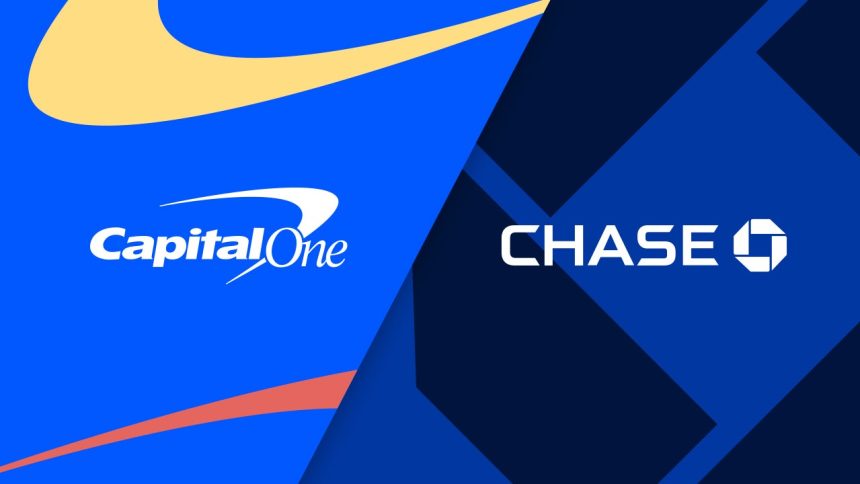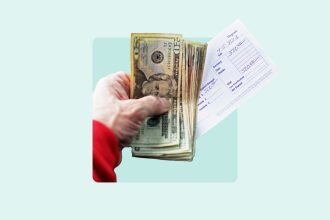Logos by CapitalOne and Chase; Illustration by Hunter Newton/Bankrate
Chase and Capital One are among the largest banks in the U.S. (measured by total assets). Both banks offer a variety of deposit products, including certificates of deposit (CDs), checking and savings accounts, but the banks differ widely in the interest rates they pay their customers and the fees they charge.
The bottom line
Here’s a comparison of Chase and Capital One overall and by each account type.
Chase vs. Capital One: Overview
| Chase | Capital One | |
|---|---|---|
| Overall Bankrate score | 3.6 stars | 4.6 stars |
| Overview | Chase has a branch in nearly every state and a highly-rated mobile app for those who prefer to bank online. But the bank pays very little interest on most of its savings products and often charges a monthly fee for accounts (though it does offer ways to waive them.) | Capital One has over 250 branch locations, but only in select states on the East coast and in the South. Unlike Chase, it pays strong rates on its savings products and doesn’t charge monthly fees on its accounts. It also offers access to a vast no-fee ATM network. |
| Pros |
|
|
| Cons |
|
|
Chase vs. Capital One: Savings accounts
Capital One offers just one savings account while Chase offers a few, including its main account, Chase Savings, which is the one we’ll compare to Capital One 360’s Performance Savings.
The bottom line: Capital One’s 360 Performance Savings offers two big things Chase’s Savings Account doesn’t: a strong interest rate and zero monthly fees.
| Chase Savings | Capital One 360 Performance Savings | |
|---|---|---|
| Bankrate score | 2.9 stars | 4.4 stars |
| APY | 0.01% | 3.50% |
| Monthly fees | $5 or $0 when requirements are met | $0 |
| Minimum deposit to open | $25 | $0 |
| Features |
|
|
| What to watch for |
|
|
Chase vs. Capital One: CDs
Chase’s standard CDs don’t earn much interest, whereas Capital One’s rates are pretty competitive. With Chase, you have the option to earn more interest if you link a qualifying checking account, (though the rates still won’t be as high as Capital One’s).
The bottom line: While Chase offers more options for CD terms, Capital One has better rates.
| Chase CDs | Capital One 360 CDs | |
|---|---|---|
| Bankrate score | 3.0 stars | 4.5 stars |
| Term lengths | One month to 10 years | Six months to five years |
| Minimum deposit to open | $1,000 | $0 |
| APY for one year | 0.01% | 4.00% |
| APY for three years | 0.01% | 3.60% |
| APY for five years | 0.01% | 3.75% |
| IRA CDs | None available | None available |
| Specialty CDs* | None available | None available |
| Featured CDs** | Available: 1.24% – 4.00% APY*** | None available |
** Featured CDs refer to promotional CDs that banks sometimes offer; they usually have non-standard terms (such as four months) and higher rates than what banks may normally offer.
***To earn the highest APY for some terms, you must have a linked eligible Chase checking account and $100,000 in deposits.
Note: Annual percentage yields (APYs) shown are as of July 24, and may vary by region for some products.
Chase vs. Capital One: Checking accounts
Chase offers a variety of checking accounts for different consumers but its flagship checking account, Total Checking, is the one we’ve compared here. Capital One offers just one checking account, the 360 Checking account.
The bottom line: Chase’s Total Checking account comes with monthly and overdraft fees, whereas Capital One doesn’t charge either and even pays a little interest on your balance.
| Chase Total Checking | Capital One 360 Checking | |
|---|---|---|
| Bankrate score | 3.9 stars | 5.0 stars |
| Monthly fees | $12 or $0 when requirements are met (this monthly fee will go up to $15 on Aug. 24, 2025) | $0 |
| Minimum deposit to open | $25 | $0 |
| APY | None | 0.10% |
| Overdraft fee | $34 for overdrafts over $50; can be charged three times a day | None |
| Features |
|
|
| What to watch for |
|
|
Chase vs. Capital One: Banking experience
One of the bigger banking experience differences between Chase and Capital One is branch access: Chase offers branches in nearly every state in the U.S. In contrast, Capital One has a much more limited geographic footprint, with branches in only nine states. But Capital One makes up for its lack of branch presence with a much larger ATM network and higher rates.
Your online experience will be good at either bank, as they both have highly-rated mobile apps that help you track and manage your money.
The bottom line: Choosing between Chase and Capital One will depend largely on how you like to bank, and which products you like most.
| Chase | Capital One | |
|---|---|---|
| Branches | Approximately 4,700 | Approximately 260 |
| Customer service | Available by phone, mail and in person. Customer service hours over the phone from 8 a.m. to 12 a.m. ET every day. | Available by phone, e-mail and mail. Phone customer service hours are every day from 8 a.m. to 11 p.m. ET. |
| ATM network | Approximately 15,000 ATMs | Approximately 70,000 ATMs |
| Mobile app rating | iOS: 4.8 Android: 4.5 |
iOS: 4.9 Android: 4.5 |
Chase vs. Capital One: Which one is best for you?
When it comes to choosing between Chase and Capital One, your decision will likely come down to what you value most in a bank — convenience or competitive rates.
Choose Chase if you prioritize branch access and a full-service banking experience.
Choose Capital One if you want to maximize your savings and avoid fees.

If branch access isn’t your priority, it’s hard to beat Capital One’s accounts, which come with robust interest rates. In contrast, the standard yields on Chase accounts tend to be rock-bottom.
— Marcos Cabello, banking writer, Bankrate
Ultimately, choosing the right bank is a personal decision. Here are some steps to take when choosing a bank:
- Determine your banking needs: Do you visit branches often? Want high savings rates? Prefer digital tools?
- Compare account features: Look at fees, APYs, ATM access and mobile app capabilities.
- Consider your future goals: Are you building an emergency fund, saving for a home or managing daily spending?
Why we ask for feedback
Your feedback helps us improve our content and services. It takes less than a minute to
complete.
Your responses are anonymous and will only be used for improving our website.
Help us improve our content
Read the full article here














